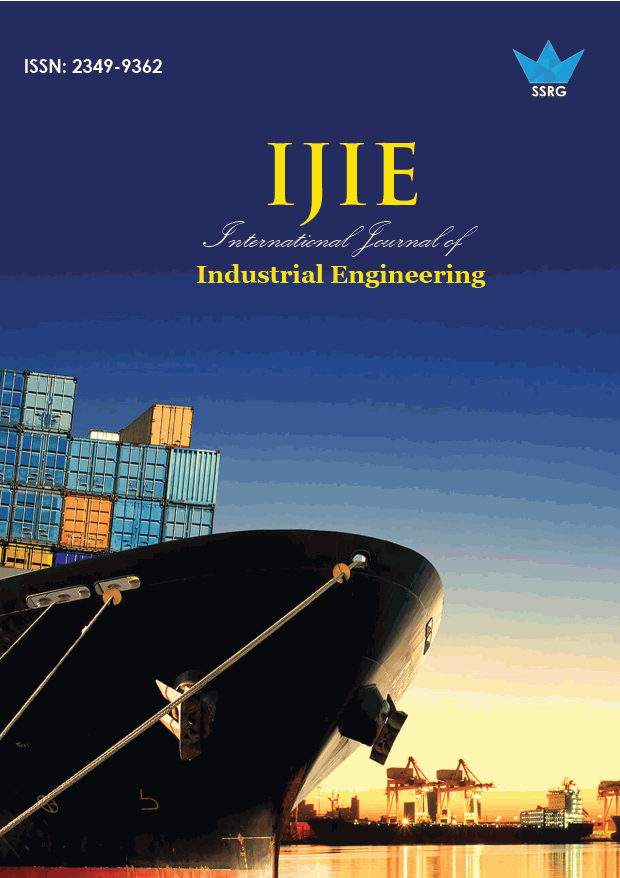A New Model for Accessibility Optimization Applied to a Series-Parallel System

| International Journal of Industrial Engineering |
| © 2015 by SSRG - IJIE Journal |
| Volume 2 Issue 3 |
| Year of Publication : 2015 |
| Authors : P. Alarmel valli, A.Vanisree and T.Sureka |
How to Cite?
P. Alarmel valli, A.Vanisree and T.Sureka, "A New Model for Accessibility Optimization Applied to a Series-Parallel System," SSRG International Journal of Industrial Engineering, vol. 2, no. 3, pp. 14-17, 2015. Crossref, https://doi.org/10.14445/23499362/IJIE-V2I5P104
Abstract:
Redundancy technique is notorious as a way to augment the reliability and accessibility of non-reparable systems, but for repairable systems, a different factor is receiving important called as the number of continuance resources. In this study, accessibility optimization of series-parallel systems is modeled by using Markovian process by which the numeral of continuation resources is positioned into the purpose model under constraints such as cost, weight, and volume. Due to difficulty of the model as nonlinear indoctrination, solving the model by profitable software is not possible, and a straightforward heuristic method called as imitation annealing is applied. Our main giving in this study is correlated to the expansion of a new availability model consider a new decision variable called as the number of continuance resources. A numerical replication is solved and the results are shown to display the proficient of the method.
Keywords:
Availability optimization, Maintenance resource, Redundancy level.
References:
[1] Barlow, R.E., Hunter, L.C., Optimum preventive maintenance policy. Operations Res, Vol (8), 1960, pp. 90–100.
[2] Barron, Y., Frostig, E., Levikson B., Analysis of r Out of n Systems with Several Repairmen, exponential life times and phase type repair times: an algorithmic approach. European Journal of Operation Research, Vol (169), 2006, pp.202–25.
[3] Castro, H.F., Cavalca, K.L., Availability Optimization with Genetic Algorithm. International Journal of Quality and Reliability Management, Vol(20), 2003, pp.847–63.
[4] David, W.C., Maximization of System Reliability with a Choice of Redundancy Strategies. IIE Transactions, Vol(35), 2003, pp.535-543.
[5] Elegbede, C., Adjallah, K., Availability Allocation to Repairable Systems with Genetic Algorithms: a Multi-Objective Formulation. Reliability Engineering and System Safety, Vol (82), 2003, pp.319–30.
[6] Frostig, E., Levikson, B., On the Availability of an r out of n Repairable Systems. Naval Research Logistics Vol(49), 2002, pp.483–98.
[7] Kirkpatrick, S., Gelatt, C.D., Vecchi, M.P., Optimization by Simulated Annealing. Sci, Vol (220), 1983, pp.671-680.
[8] Kuo,W., Prasad, V.R., Tillman, F.A., & Hawang, C.(2001). Optimal reliabilitydesign fundamental and application. London: Cambridge University Press.
[9] Levitin, G., Lisnianski, A., Joint Redundancy and Maintenance Optimization for Multistate Series-Parallel Systems. Reliability, Engineering and System Safety Vol(64), 1999, pp.33–42.
[10] Metropolis, N., Rosenbluth, M.N., Teller, A.H., Equation of State Calculations by Fast Computing Machines. Journal of Chemical Physics, Vol (21), 1953, pp.1087-1093.

 10.14445/23499362/IJIE-V2I5P104
10.14445/23499362/IJIE-V2I5P104